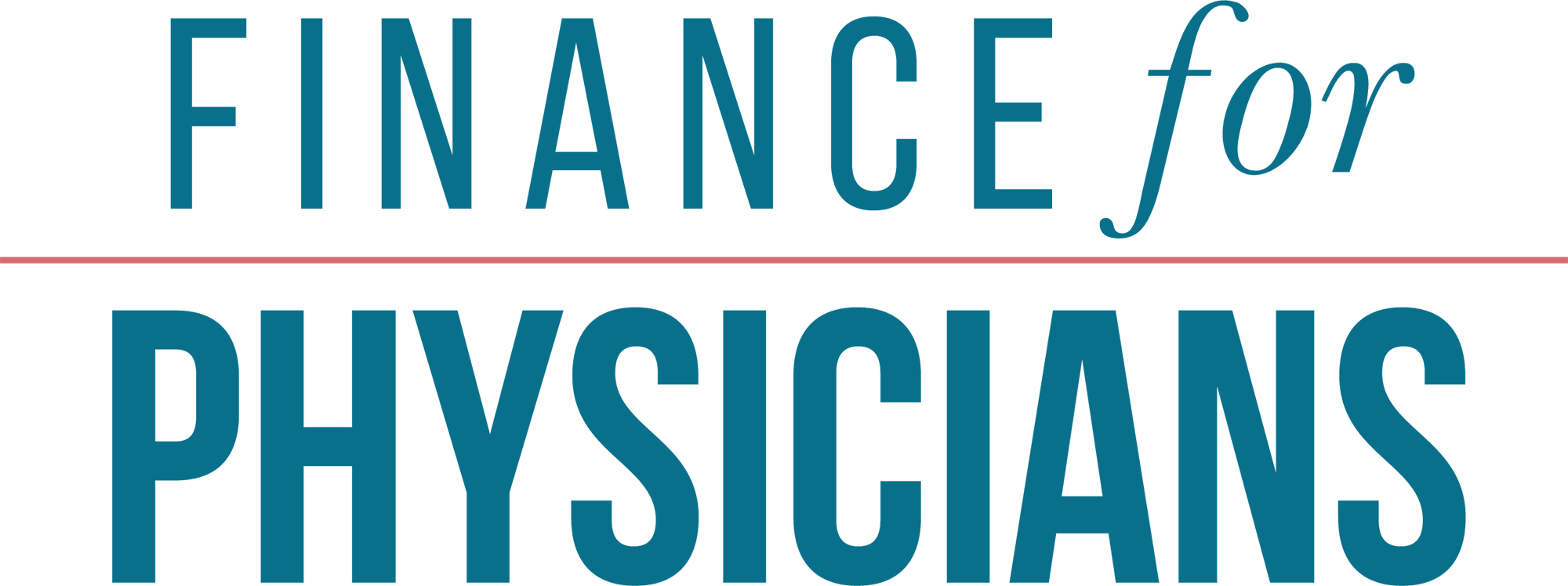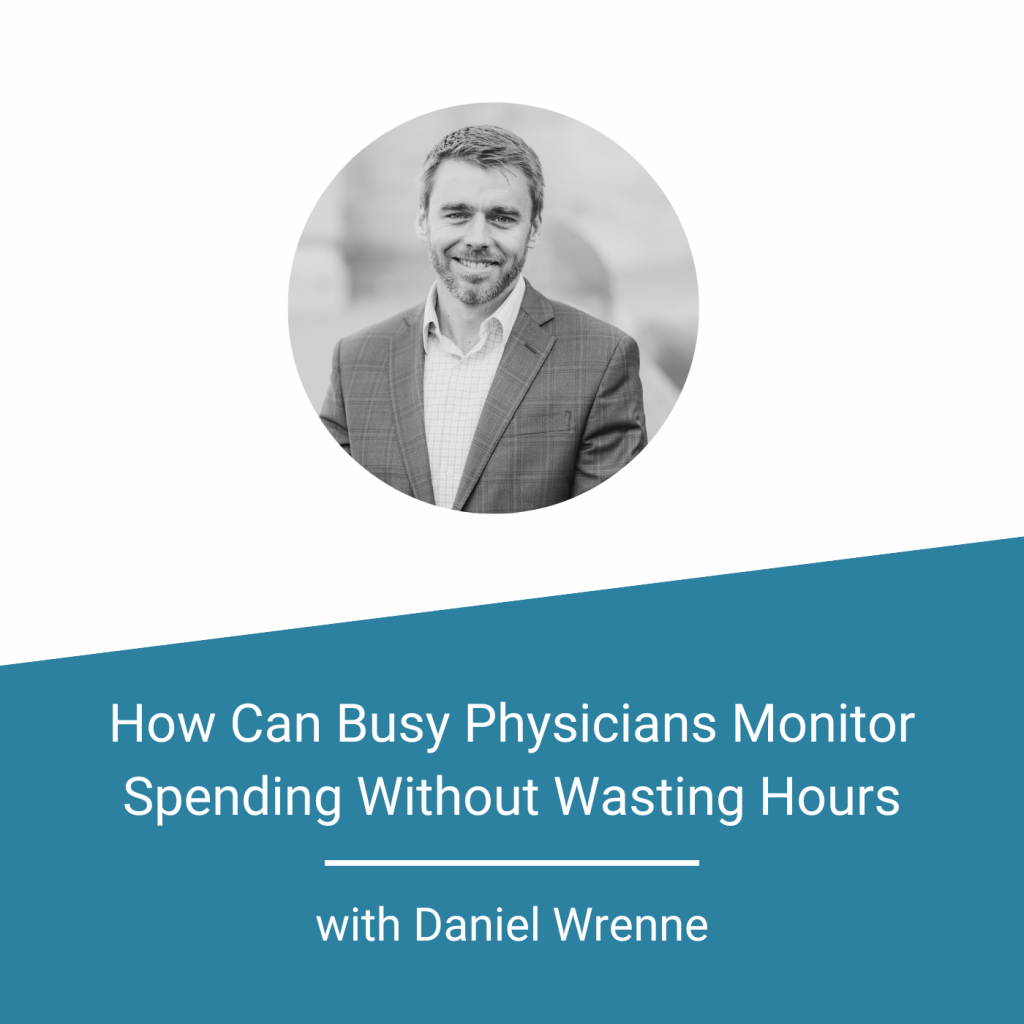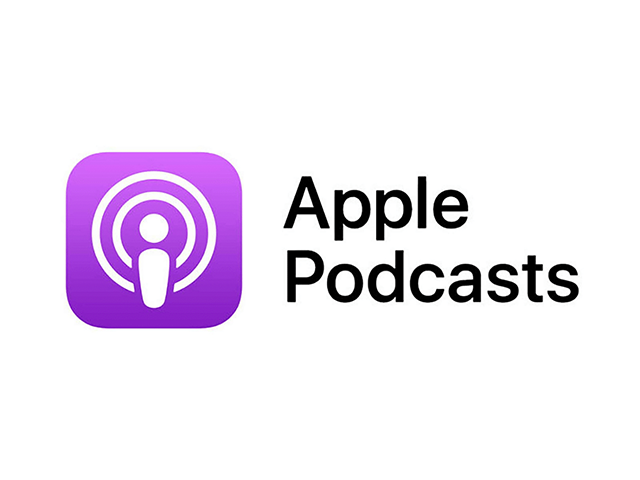Does it take you hours and hours to count and track every single expense, every single month? How can you monitor your spending without spending too much time that you do not have and cannot afford to waste?
In this episode of the Finance for Physicians Podcast, Daniel Wrenne talks about how busy physicians can monitor spending without wasting hours by using a basic system that he developed to keep a pulse on cash flow and total household expenses.
Topics Discussed:
- Goal: Make sure you’re not overspending or that your spending is aligned
- Cash Flow Tracking System: Shows if you’re on track or you’re slipping up
- Do’s and Don’ts: System only works if you do pay off credit card debt monthly
- Cash Balances: System watches them over time based on your spending
- Numbers: Starting cash balance, income, ending cash balance, and expenses
- What do your expenses need to be? What if they aren’t what they should be?
- Financial Plan: Decide how much for your lifestyle vs. spending vs. values/goals
- Categorization: Come up with categories that you want to sort everything by
- Expense Audit: Identify and plan what to cut/reduce by stopping/changing habits
Links:
Contact Finance for Physicians
Full Episode Transcript:
What’s up, everyone? I am recently returning from a podcast conference. Basically, a bunch of people like myself got together, shared ideas, and talked about how to improve.
My goal up to this point has been just to basically produce episodes and share as much value as I can. Now that I’ve been at it for (I guess) a little over a year, maybe close to a year-and-a-half, the goal going forward is to start to proactively grow and really fine-tune the skill.
This conference was super helpful in getting some ideas. I want to fill you guys in on that before we jump into the episode today, and share a couple of other things I’m going to be working on.
Like I said, the big goal going forward is to really focus on growth and adding value, which has been my primary goal all along, is how do I get as many people listening as possible, and make sure it is valuable as possible.
I got a lot of ideas from the conference. I’ll share those over time and you’ll start to see those come out over time as we implement them, but there are a couple I’ll throw out today.
In terms of value add, a couple of ideas that I took away from that conference was along the lines of improving engagement. A couple of other things I’m thinking about is maybe doing some live format, where we allow the ability for guests to participate more in-shows, throw out questions, and just make it more interactive, with the goal being to make it more community-focused. Or maybe having a Facebook group where we’re doing form-type setup and having conversations.
I have a lot of different ideas along the lines of building community and improving the interaction among you guys, so if you have ideas along those lines please share those. Ultimately, this show is for you guys, so I want to hear if you guys have ideas for how to provide more value and be more engaged. Ultimately, I want to know what you guys are looking for and what’s what we’re after.
That’s the first big thing that I’m working on. The other big thing is growth. The goal there is to naturally grow through providing maximum value. Plus I think I’ll try to do a little bit more promotion, maybe on social media, although I’m not the most engaged. I’m not the social media type.
Another big thing is potentially getting on other people’s podcasts. If you know of people that either might be good guests for this or podcasts that might be good for me to attempt to get on, please throw those out as well because we’ll be looking to do that in the future.
More info to come. I just want to throw you guys in on that. Super exciting to see how many people are working in that space, and there are a lot of people with great ideas. The goal is to work through these things to continually improve on what this podcast is providing ultimately for you guys.
The goal today was to talk about expenses and monitoring expenses without spending hours and hours. I know that is a common issue. You’re probably thinking of budgeting when we talk about budgeting. We kind of are, but when I think of budgeting, I’m like, gross. That sounds terrible. I don’t really want to budget. Budgeting sounds painful to me.
I think of counting every single expense every single month and hours and hours of time. That is commonly what it turns into, especially when you’re tracking every single expense. It’s also a common cause of arguments with couples when you get into the weeds. Not that budgeting is always bad, but I don’t think it’s a great starting point. So we’re going to talk about how to monitor your spending without getting into the weeds, and without spending hours and hours of time.
Through my work with physician families one-on-one, and also just with my own personal finances, I’ve developed a system. It’s very, very basic. It’s nothing. I’m sure tons of people have used this before, but it’s a system that really works well for just keeping a pulse on cash flow and total expenses.
For most people, that’s really all you need to do most months. I’ll talk about my experience with this as we go through this because I’ve seen the ups and downs in this. I think the goal is most people just want to make sure they’re not overspending or make sure their spending is in line with what they want it to be.
This system will (at minimum) show you if you’re on track. It’ll also give you awareness if you’re slipping, if your lifestyle is starting to creep up. I’m going to talk through this cash flow tracking system.
Basically, the system involves monitoring your total cash balances between your checking and savings account over time, and your income, and then using those values to back into what your expenses are.
First of all, this is not going to work if you have consumer debt that you’re not paying off every month. If that’s you, you have to take care of that first. This is just not going to work for that. But assuming you’re paying off all your credit card debts every single month, this system to monitor will work.
We’re looking at cash balances. Really the system is watching those cash balances over time and backing into what your spending is based on that. The way I do it is monthly. You could do it at any frequency, but I like monthly. It’s how I track everything else.
Let’s say we’re looking at May of 2022. What I’m going to do is—I use a spreadsheet, but you could use paper—I’m going to look at May. The first number I’m going to write down is my starting balance between all my cash accounts—checking account, savings account—total them up, that’s my starting cash balance at the start of the month. Let’s say it was a thousand, so I started May with $1000.
The next number I figure out is how much income came in. The reason we’re using this approach is because it’s simple. Hopefully, you have much less, much fewer transactions for income.
For example, between our accounts we only have three or four income-lined items each month. With our clients, we typically see anywhere from a couple of transactions to maybe 15 at most. All you’re doing is totalling up all the income that came into your accounts for the month. Let’s just (for example) say that number is $5000.
The third number you’re looking at is the ending all cash balance. So same thing as the first number, except we’re just looking at the end of the month total between all the accounts cash balance. Let’s say that number is $1100. You started the month with $5000. Five thousand dollars came into the account and now you have $1100. That would mean that your expenses were $4900. In other words, your surplus was $100.
The reason I love this approach is because it allows you to back into this total number, in this example $4900. It allows you to back into what your total expenses are very easily. It takes me 10 minutes a month to update these numbers.
I know what that number needs to be for us. I can do a quick check and see if it’s in the range of what I want it to be, I just write down those four numbers and I move on. Usually it’s over for us and most people, but if it’s over or under, you can take action based on that, so I’ll talk about that in a second.
I have gotten in the habit of doing this every month, just once a month. I write down those three numbers, starting cash income, ending cash, then I back into the expenses so it ends up being four numbers, and I just document it for June, July, August, September.
The other thing is after you’ve been doing this for a while, you get a nice rolling tally of what your lifestyle is, and it’s just a much more accurate representation as opposed to just looking at one month.
That’s my simple system for tracking cash flow or total household expenses. Another common question—probably the most common question—that comes up as a result to this, is what if my expenses are not what I want them to be? Or maybe even before that, the question is what do my expenses need to be?
That’s a personal question and I think the best thing to do is have a financial plan. Part of the value of a financial plan is deciding how much your lifestyle should be versus how much you should be spending versus how much you should be giving away and tying that into your values and goals.
Ideally, you have a financial plan and can use that to drive what your expenses should be. If you don’t have that, that’s got to be step one, because otherwise, you’re just flying blind. Once you have a plan and you know what your expenses should be, then that’s what you’re going to be using as a benchmark or a line in the sand.
Going back to the example I just gave, say your number needs to be $4000 of expenses. We just saw it was $4900 or maybe the past 3 months it’s been averaging $5000 or $4900 or somewhere in that range. In other words, you’re over by close to a thousand dollars. What do you do then? What I would suggest at that point, that’s when you dig deeper.
Lately, I have had that happen with my own tracking. I think everybody, a lot of people that I’ve talked to lately had had this happen. It seems like people are spending money plus things are getting more expensive. There’s been all this COVID travel pent-up lack of spending.
I’m one of those people. Our lifestyle has creeped up the past six months to a year. And now it’s gotten outside the bounds that I would like it to be. What we do in this situation is that’s when we dig into the expenses. At that point, I would do what I call an expense audit. Basically, you’re just going to dig in a little bit more.
I just did it earlier today, so it’s fresh. What I basically did is—I’m recording this June 2022—I looked at April and May, and I’m auditing those two months. First thing is what period of time are you going to audit or dig into? I typically suggest two, maybe three months at the most. You don’t want to make it too intense. I took April and May.
First step is I’m going to go to all the accounts that I spend money on and log into them. For us, there are three different credit cards and one checking account where transactions happen. I logged into all four of those accounts and downloaded my transaction history in an Excel spreadsheet for April to the end of May, so for the two months. I just downloaded all those accounts into a spreadsheet and then I pull them all together into one spreadsheet.
That’s the data. You pull all that into a spreadsheet. Then you have to take out the income and transfers. Sometimes, they’re just irregular things that you need to take out. Really, I’m focusing on expenses. If it’s a credit card payment, I take that out because that’s already going to be accounted for. I want to know what was swiped on the credit card. A credit card payment is not an expense. That’s just money moving places.
I take the income out. I take the transfers from one account to the other out. I take the credit card payments out, that sort of thing. I got to take all that out first. Then for my account, I have to make sure some of the accounts show refunds as positive expenses. I had to add a negative to those because that’s a refund. We took something back and got a refund. I had to do some small corrections like that.
Basically, you’re just reviewing your list of transactions from a high-level standpoint and saying, is there anything I need to take out? Is there anything I need to adjust? Ultimately, I made some tweaks to make it so that it’s strictly our transactions for expenses from those accounts for April and May.
Then I’m going to go through and just categorize it. I would suggest using broad categories for categorization, like home or entertainment or travel or food. Food would be eating out, groceries. Or maybe you could use food/eating out and then food/groceries. Transportation is one I add. Basically, come up with the categories that you want to sort everything by.
There’s always going to be an other or an unknown category. But come up with a big category that you’re going to sort everything by. Then go through the spreadsheet, identify which category all the transactions are going to be. Then total up by category.
This is kind of painful, I’ll be honest. It takes an hour or two. The whole point of this is not doing this exercise every month. This would suck to do every single month. I’m sure you could come up with some automations or what not to make it faster. But either way, it’s painful to go through each individual transaction.
The whole idea of this system is to track cash flow and get into the weeds every so often. For us, we’re typically doing this deep dig every year on average probably, or nine months to a year. It does take some time, maybe one or two hours. Ideally, you’re coming away with a very accurate representation of what your expenses are by category.
Once you have it all categorized and you have summed up those transactions by category, then I would start to review the totals for each category, and maybe even review some of the individual transactions. This needs to be with your spouse or whomever you’re sharing your expenses with if you’re doing that.
As a couple, you’re going through and reviewing each of these. You can’t be judgemental. You can’t be finger-pointing if there are two of you. You are going to review them and say, let’s start to highlight—maybe even do it on paper so you can literally highlight it—some of these transactions that we might consider cutting.
Each of you go through and highlight as many transactions as you think might be transactions you cut, not that you will cut or change or something. As you do that, I think it’s important to remember what’s most important, your values, and your goals. You’re going to naturally go that direction, but I think it’s a good reminder to think about what’s most important.
For example, for me, and this is where it gets tricky. I don’t really have a high value on clothes, for example. I don’t really spend anything on clothes. So when I see transactions for shopping at clothing stores, I’m like ugh. So that’s a low value thing for me. My wife is not super into that, but she definitely values that more than I do. She’s going to rank it a little higher, I’m going to rank it low. On the other hand, I definitely value traveling, so I’m going to be considering that a very high value expense.
Ideally, you’re looking for things that you both don’t really value that high. Or even something that you completely don’t use. That’s low-hanging fruit. Almost always when we go through this, we’re going to see some just straight low-hanging fruit. Like a Netflix subscription that we never use, that’s low-hanging fruit. That’s an obvious one.
Or maybe we’re getting carry-out food or something more than normal. Both myself and my wife don’t value that really at all. If we’re going to eat or spend money on food, we want to go to a nice restaurant. Carry-out is not that valuable to us. Really, we do it a lot of times when we get busy or lazy or whatever. So that’s something we definitely will often identify as something to cut, just that carry-out type.
Or spending in a super convenient grocery store right across the street, but it’s way more expensive. Those are the types of things that typically get highlighted on my list, but everybody’s list is going to look different.
Once you’ve identified all of those or highlighted all of those, then you talk through those with your spouse and star the things you’re going to cut or work on reducing.
Once you star all the things you’re going to work on adjusting, you have to make a plan to do it, especially if it’s an entrenched habit, like dining out or carry-out can become a super entrenched habit. You have to focus on how you’re going to stop or change the habit. Habit change is not easy. You have to remember to make a plan.
Sometimes, it’s as easy as just going online and canceling the Netflix subscription. Other times, it’s like how are we going to not eat out as much? Well, I don’t know. You can come up with something creative, say maybe if we spend less than $100 dining out next month, we can buy ourselves a treat or something.
You can use some of those habit tricks to encourage or incentivize yourself to do it. Or you could just stop using your credit card because that makes it easy to swipe for certain things. The key is to make a concrete plan for changing it.
Going even further, as you free up money you want to make sure it does its thing. If you’re freeing up money, it’s going to have to go somewhere. Think about where you would like it to go. Maybe you’re spending in a different category. Maybe you’re giving it away. Maybe you’re saving or investing it. Whatever it is, ideally you’re making a plan for that to happen.
For example, if you need to save more for education for your children, the key is to cancel the Netflix subscription and at the exact same moment, like in an ideal world, you adjust the 529 contribution up by that exact amount. The dollars have basically just gone from one category to the other.
That’s how the expense audit works. It worked well for us. Myself and my wife have had good results doing that. It is painful, but it’s not something we do every month by any means. We’ve had a lot of clients that use a similar approach.
The key is it doesn’t need to be perfect. This temptation with budgeting is if you’re going to budget, you need no other expense. But I don’t think that’s the right way to look at it. Knowing what your total expenses are is very valuable and is much better than knowing nothing. A lot of people are like, I’m going to budget perfectly. Then they get into it and they’re like, this sucks. I’m never budgeting at all. Knowing your total expenses is much better than not budgeting at all.
Ideally, you’re keeping a pulse on total expenses. And that’s keeping you out of the weeds. But then you know when the alarm bells are sounding and you can jump into the weeds every once in a while, and make some adjustments so that you’re not having that lifestyle creep we talk about a lot.
That’s what happens pretty much for everybody. If you’re not looking at this, it’s happening for me right now. We’ve had lifestyle creep just over the past six months to a year. What’s important, though, is I’m aware of that. I see it happening, so that’s why I’m jumping into the weeds.
I hope this has been helpful, and as always, I enjoy chatting with you. We look forward to talking next time.









